Extensive dissemination and intraclonal maturation of HIV Env vaccine-induced B cell responses
- PMID: 31704807
- PMCID: PMC7041718
- DOI: 10.1084/jem.20191155
Extensive dissemination and intraclonal maturation of HIV Env vaccine-induced B cell responses
Abstract
Well-ordered HIV-1 envelope glycoprotein (Env) trimers are prioritized for clinical evaluation, and there is a need for an improved understanding about how elicited B cell responses evolve following immunization. To accomplish this, we prime-boosted rhesus macaques with clade C NFL trimers and identified 180 unique Ab lineages from ∼1,000 single-sorted Env-specific memory B cells. We traced all lineages in high-throughput heavy chain (HC) repertoire (Rep-seq) data generated from multiple immune compartments and time points and expressed several as monoclonal Abs (mAbs). Our results revealed broad dissemination and high levels of somatic hypermutation (SHM) of most lineages, including tier 2 virus neutralizing lineages, following boosting. SHM was highest in the Ab complementarity determining regions (CDRs) but also surprisingly high in the framework regions (FRs), especially FR3. Our results demonstrate the capacity of the immune system to affinity-mature large numbers of Env-specific B cell lineages simultaneously, supporting the use of regimens consisting of repeated boosts to improve each Ab, even those belonging to less expanded lineages.
© 2019 Phad et al.
Figures

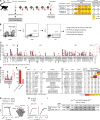
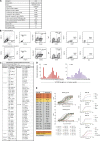

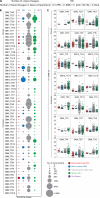
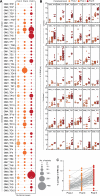




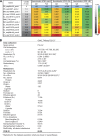

Similar articles
-
HIV-1 Cross-Reactive Primary Virus Neutralizing Antibody Response Elicited by Immunization in Nonhuman Primates.J Virol. 2017 Oct 13;91(21):e00910-17. doi: 10.1128/JVI.00910-17. Print 2017 Nov 1. J Virol. 2017. PMID: 28835491 Free PMC article.
-
High-Resolution Longitudinal Study of HIV-1 Env Vaccine-Elicited B Cell Responses to the Virus Primary Receptor Binding Site Reveals Affinity Maturation and Clonal Persistence.J Immunol. 2016 May 1;196(9):3729-43. doi: 10.4049/jimmunol.1502543. Epub 2016 Mar 21. J Immunol. 2016. PMID: 27001953 Free PMC article.
-
Polyfunctional Tier 2-Neutralizing Antibodies Cloned following HIV-1 Env Macaque Immunization Mirror Native Antibodies in a Human Donor.J Immunol. 2021 Mar 1;206(5):999-1012. doi: 10.4049/jimmunol.2001082. Epub 2021 Jan 20. J Immunol. 2021. PMID: 33472907 Free PMC article.
-
On the benefits of sin: can greater understanding of the 1F7-idiotypic repertoire freeze enhance HIV vaccine development?Hum Vaccin Immunother. 2013 Jul;9(7):1532-8. doi: 10.4161/hv.24460. Epub 2013 Apr 9. Hum Vaccin Immunother. 2013. PMID: 23571168 Review.
-
HIV Broadly Neutralizing Antibodies: VRC01 and Beyond.Adv Exp Med Biol. 2018;1075:53-72. doi: 10.1007/978-981-13-0484-2_3. Adv Exp Med Biol. 2018. PMID: 30030789 Review.
Cited by
-
Multi-compartmental diversification of neutralizing antibody lineages dissected in SARS-CoV-2 spike-immunized macaques.Nat Commun. 2024 Jul 27;15(1):6338. doi: 10.1038/s41467-024-50286-0. Nat Commun. 2024. PMID: 39068149 Free PMC article.
-
Adaptive immune receptor genotyping using the corecount program.Front Immunol. 2023 Apr 11;14:1125884. doi: 10.3389/fimmu.2023.1125884. eCollection 2023. Front Immunol. 2023. PMID: 37114042 Free PMC article.
-
Detection of PCR chimeras in adaptive immune receptor repertoire sequencing using hidden Markov models.bioRxiv [Preprint]. 2025 Feb 26:2025.02.21.638809. doi: 10.1101/2025.02.21.638809. bioRxiv. 2025. PMID: 40060431 Free PMC article. Preprint.
-
IMGT® Biocuration and Analysis of the Rhesus Monkey IG Loci.Vaccines (Basel). 2022 Mar 3;10(3):394. doi: 10.3390/vaccines10030394. Vaccines (Basel). 2022. PMID: 35335026 Free PMC article.
-
A third dose of the unmodified COVID-19 mRNA vaccine CVnCoV enhances quality and quantity of immune responses.Mol Ther Methods Clin Dev. 2022 Dec 8;27:309-323. doi: 10.1016/j.omtm.2022.10.001. Epub 2022 Oct 6. Mol Ther Methods Clin Dev. 2022. PMID: 36217434 Free PMC article.
References
-
- Adams P.D., Afonine P.V., Bunkóczi G., Chen V.B., Davis I.W., Echols N., Headd J.J., Hung L.W., Kapral G.J., Grosse-Kunstleve R.W., et al. . 2010. PHENIX: a comprehensive Python-based system for macromolecular structure solution. Acta Crystallogr. D Biol. Crystallogr. 66:213–221. 10.1107/S0907444909052925 - DOI - PMC - PubMed
-
- Bonsignori M., Zhou T., Sheng Z., Chen L., Gao F., Joyce M.G., Ozorowski G., Chuang G.Y., Schramm C.A., Wiehe K., et al. . NISC Comparative Sequencing Program . 2016. Maturation Pathway from Germline to Broad HIV-1 Neutralizer of a CD4-Mimic Antibody. Cell. 165:449–463. 10.1016/j.cell.2016.02.022 - DOI - PMC - PubMed
-
- Cirelli K.M., Carnathan D.G., Nogal B., Martin J.T., Rodriguez O.L., Upadhyay A.A., Enemuo C.A., Gebru E.H., Choe Y., Viviano F., et al. . 2019. Slow Delivery Immunization Enhances HIV Neutralizing Antibody and Germinal Center Responses via Modulation of Immunodominance. Cell. 177:1153–1171.e28. 10.1016/j.cell.2019.04.012 - DOI - PMC - PubMed
Publication types
MeSH terms
Substances
Grants and funding
LinkOut - more resources
Full Text Sources
Other Literature Sources
Medical

